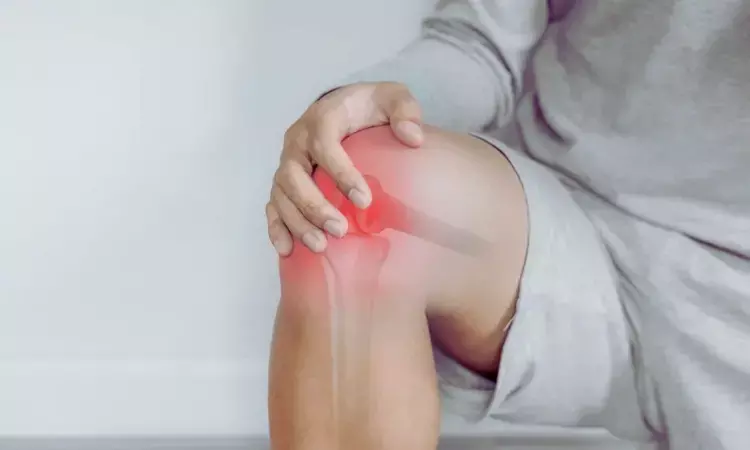- Home
- Medical news & Guidelines
- Anesthesiology
- Cardiology and CTVS
- Critical Care
- Dentistry
- Dermatology
- Diabetes and Endocrinology
- ENT
- Gastroenterology
- Medicine
- Nephrology
- Neurology
- Obstretics-Gynaecology
- Oncology
- Ophthalmology
- Orthopaedics
- Pediatrics-Neonatology
- Psychiatry
- Pulmonology
- Radiology
- Surgery
- Urology
- Laboratory Medicine
- Diet
- Nursing
- Paramedical
- Physiotherapy
- Health news
- Fact Check
- Bone Health Fact Check
- Brain Health Fact Check
- Cancer Related Fact Check
- Child Care Fact Check
- Dental and oral health fact check
- Diabetes and metabolic health fact check
- Diet and Nutrition Fact Check
- Eye and ENT Care Fact Check
- Fitness fact check
- Gut health fact check
- Heart health fact check
- Kidney health fact check
- Medical education fact check
- Men's health fact check
- Respiratory fact check
- Skin and hair care fact check
- Vaccine and Immunization fact check
- Women's health fact check
- AYUSH
- State News
- Andaman and Nicobar Islands
- Andhra Pradesh
- Arunachal Pradesh
- Assam
- Bihar
- Chandigarh
- Chattisgarh
- Dadra and Nagar Haveli
- Daman and Diu
- Delhi
- Goa
- Gujarat
- Haryana
- Himachal Pradesh
- Jammu & Kashmir
- Jharkhand
- Karnataka
- Kerala
- Ladakh
- Lakshadweep
- Madhya Pradesh
- Maharashtra
- Manipur
- Meghalaya
- Mizoram
- Nagaland
- Odisha
- Puducherry
- Punjab
- Rajasthan
- Sikkim
- Tamil Nadu
- Telangana
- Tripura
- Uttar Pradesh
- Uttrakhand
- West Bengal
- Medical Education
- Industry
Routine Bladder Scanning Reduces Postoperative Hyponatremia After Joint Replacement: Study

Hyponatraemia is a frequent complication after joint replacement surgeries, often arising from fluid and electrolyte imbalances in the postoperative period. In a new article published in BMC Nephrology, Mamdouh Hefny, Raheel Faiz, Alexander Denning, Paul Saunders, and colleagues propose that routine bladder ultrasound scanning integrated into postoperative fluid management can significantly reduce the incidence of hyponatraemia. By distinguishing urinary retention from true acute kidney injury, the authors argue that more appropriate, tailored fluid administration becomes possible, decreasing the risk of dilutional hyponatraemia.
The authors studied outcomes before and after implementing a bladder scanning protocol at a single centre. In their retrospective review, hyponatraemia was common among patients undergoing elective joint arthroplasty. After introducing routine scans to monitor bladder volume at fixed intervals and using those data to guide fluid therapy decisions, the incidence of postoperative hyponatraemia fell markedly, while the rate of acute kidney injury remained stable. The authors emphasize that urinary retention can mimic low urine output, leading clinicians to mistakenly administer excess fluid, thereby provoking dilutional hyponatraemia. By comparing bladder volumes over time, one can better distinguish whether low output is caused by retention or by true renal dysfunction, and respond accordingly.
What this really means is that incorporating bladder scanning into postoperative management offers a relatively simple, noninvasive tool to improve fluid-electrolyte balance after joint replacement. The study suggests that continuous education of clinical staff and targeted interventions based on scan results can further enhance outcomes. While limitations include the single-centre design and relatively small prospective cohort, the findings are promising. They point toward a shift in postoperative protocols for arthroplasty care—one where routine bladder assessment helps prevent iatrogenic hyponatraemia without compromising renal safety. Published in BMC Nephrology, this study adds valuable insight into optimizing electrolyte management in orthopaedic surgery.
Reference:
Hefny, M., Faiz, R., Denning, A., Saunders, P., et al. (2025). Hyponatraemia, AKI, and urinary retention following elective joint arthroplasty. BMC Nephrology, 26, Article 552. https://doi.org/10.1186/s12882-025-04473-w
Dr. Shravani Dali has completed her BDS from Pravara institute of medical sciences, loni. Following which she extensively worked in the healthcare sector for 2+ years. She has been actively involved in writing blogs in field of health and wellness. Currently she is pursuing her Masters of public health-health administration from Tata institute of social sciences. She can be contacted at editorial@medicaldialogues.in.
Dr Kamal Kant Kohli-MBBS, DTCD- a chest specialist with more than 30 years of practice and a flair for writing clinical articles, Dr Kamal Kant Kohli joined Medical Dialogues as a Chief Editor of Medical News. Besides writing articles, as an editor, he proofreads and verifies all the medical content published on Medical Dialogues including those coming from journals, studies,medical conferences,guidelines etc. Email: drkohli@medicaldialogues.in. Contact no. 011-43720751


